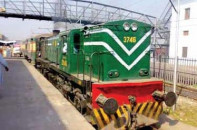The mystery of the missing containers
A confidential report had revealed that 400 Afghanistan bound containers had gone missing.

Two years down the line, the then Chief Collector Customs, Munir Qureshi, now serves as member Customs, Federal Board of Revenue (FBR) yet no action has been taken on the report to date.
A year prior to the scam in 2008, the authorities also found 180 containers missing from Post Qasim. An official at the FBR headquarters laid the blame on the Pakistan Customs Computerised System (PACCS). However, later it was established that the manual clearance system had been used and reportedly the allegation was aimed at shutting down the computerised system. The Customs Intelligence report states the basis of scam was “the clearance of containers on fake documents.”
Intelligence officials managed to arrest a clearing agent who took responsibility for the missing containers, Mohammad Naeem Qureshi, who also disclosed the names of his accomplices within Customs. However, those accomplices were never arrested. Customs staff went on strike and the FBR headquarters allegedly exercised its influence to ensure the enquiry ceased.
In June 2010, media reports claimed that over 11,000 containers had disappeared enroute to Afghanistan. These reports also suggested that the containers were carrying goods for the International Security Assistance Force and Nato troops fighting in Afghanistan. Later, the FBR clarified that only 43 containers had disappeared and admitted that liquor had been smuggled by being misrepresented as regular beverages. In response to a question, Qureshi said that it was a petty matter not worth reporting. However, had he been a functionary of a real democracy, he would have been asked to resign.
The FBR has accepted that forged documents were used to clear containers through Karachi port by using the manual clearance system.
The use of fake documents, clearance of goods through the manual system and involvement of Customs officials are common characteristics in all three incidents. While two of these have been widely reported in the press, the last was brushed under the carpet by the FBR.
FBR officials have said that a few simple solutions can prevent missing containers and smuggling in the future. These include scanning of Isaf containers, amendments in Customs General Orders 2002 and restrictions on Afghanistan-bound imports.
A former chairman of the Federal Board of Revenue, Abdullah Yusuf, said that the solution to all mega scandals is a web-based clearance system for imported goods such as the PACCS. He stressed that the system should be continued rather than scrapped.
But instead of rolling the PACCS out all over the country, authorities have decided to wind up the pilot project by July 31 as the FBR has not renewed its contract with Agility International, software providers of the PACCS.
In 2004, the pilot project was awarded to a syndicate of Agility, Microsoft and Accounting Outsource Services run by Ali Arshad Hakeem who is also chairman of the National Database and Registration Authority. Out of a total cost of $200,000, only $70,000 has been paid to the group so far.
Some within the FBR are set to permanently shut down the web-based programme despite its evident advantages. An attempt was even made to draw the curtain on the pilot project before July 31 by trying to persuade the finance minister that PACCS was a security risk. Reportedly, he was told that an intelligence agency had given a negative report about the project. However, Q Block insiders said that when Dr Abdul Hafeez Shaikh contacted the top boss of the agency he was completely unaware of the said report.
The PACCS system leaves little room for fraud since its server is connected with the bank, the terminal operator, the importer as well as the exporter. After paying the applicable tax, importers are automatically provided with a machine number for container clearance. Thus, no fake entry is possible using the computerised system.
In comparison, the manual system relies on human beings and the use of physical documents, making it susceptible to fraudulent activity. Experts suggest that instead of closing down PACCS, the government should heavily rely on the automated system. They say that the case of the disappearing containers can be solved by installing electronic scanners at Torkham border and linking them with the PACCS server. The scanners have already been installed in Karachi and there is a dire need to install them in Peshawar and Torkham.
How the PACCS unearthed the unreported scam in 2008
The PACCS computer is linked with the terminal gate and any outgoing container is automatically registered in the system. PACCS operatives were alarmed in 2008 when they noticed Afghanistan-bound trucks returning within two to twenty-four hours of departure whereas Afghanistan-bound trucks typically take a minimum of eight days to return to the port.
Published in The Express Tribune, July 5th, 2010.



















COMMENTS
Comments are moderated and generally will be posted if they are on-topic and not abusive.
For more information, please see our Comments FAQ